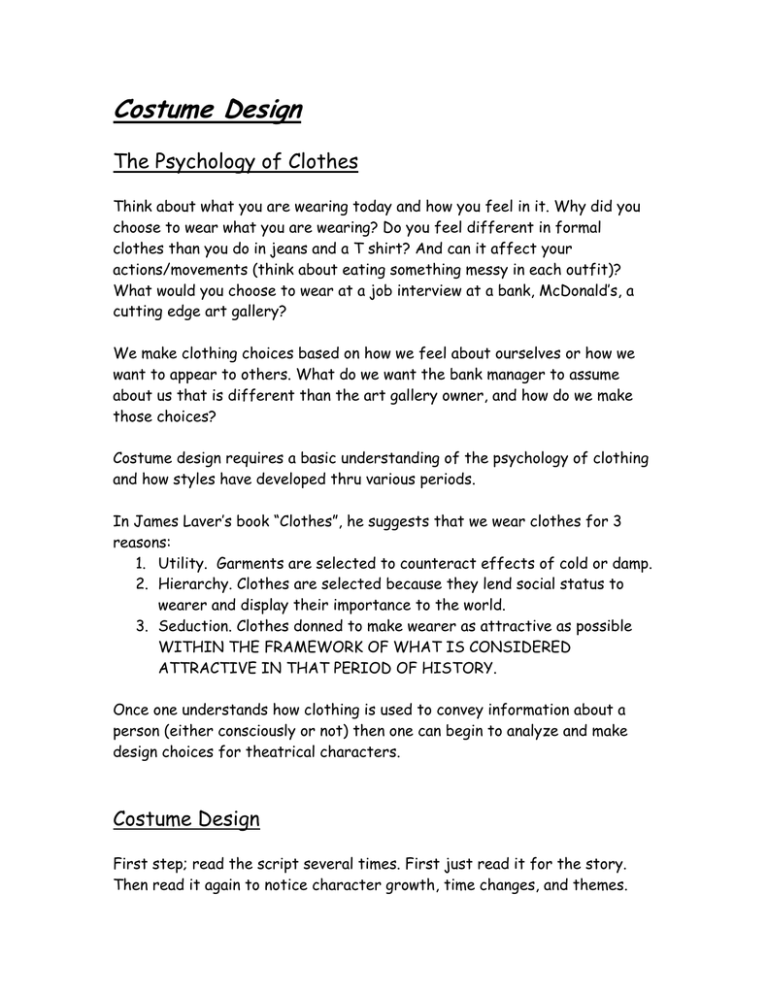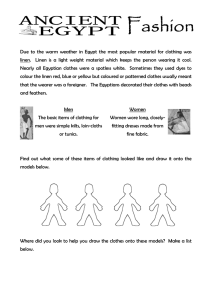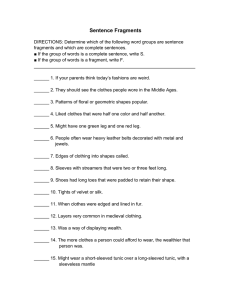Costume Design The Psychology of Clothes
advertisement

Costume Design The Psychology of Clothes Think about what you are wearing today and how you feel in it. Why did you choose to wear what you are wearing? Do you feel different in formal clothes than you do in jeans and a T shirt? And can it affect your actions/movements (think about eating something messy in each outfit)? What would you choose to wear at a job interview at a bank, McDonald’s, a cutting edge art gallery? We make clothing choices based on how we feel about ourselves or how we want to appear to others. What do we want the bank manager to assume about us that is different than the art gallery owner, and how do we make those choices? Costume design requires a basic understanding of the psychology of clothing and how styles have developed thru various periods. In James Laver’s book “Clothes”, he suggests that we wear clothes for 3 reasons: 1. Utility. Garments are selected to counteract effects of cold or damp. 2. Hierarchy. Clothes are selected because they lend social status to wearer and display their importance to the world. 3. Seduction. Clothes donned to make wearer as attractive as possible WITHIN THE FRAMEWORK OF WHAT IS CONSIDERED ATTRACTIVE IN THAT PERIOD OF HISTORY. Once one understands how clothing is used to convey information about a person (either consciously or not) then one can begin to analyze and make design choices for theatrical characters. Costume Design First step; read the script several times. First just read it for the story. Then read it again to notice character growth, time changes, and themes. Read it the third time taking notes on information the script gives you about the characters. This information falls into two groups; objective and subjective. Objective info: Gender Age Occupation Social status Geographical location Season Time of day Period Action previously performed or about to be performed Subjective info: Personality of wearer Attitude of wearer both of self and of others How the clothes get worn Note: sometimes you will be required to present erroneous information in support of the story of the play (i.e.: woman disguised as man). Ideally when a character walks on stage the audience should unconsciously get some messages about him/her before they even speak. Production All of this information goes under the umbrella of the director’s concept, which is how the director wants to tell the story. This can affect period, color palette, gender, etc. Once the period and venue is decided on the research begins. Research usually involves paintings, writings, foots, magazines or catalogues. Primary research (sources from the period) is most valuable. It is also important to have a sense of what else was going on in the period as much of what we see in each period is affected by the same events. After design meetings the designers work up renderings. Although it is a little scary for most to put paint to paper and attempt to represent the human form, there are some shortcuts and aides. In designing costumes one uses the principles of design; line, color, silhouette, texture and scale. Each of these elements can be manipulated to convey feelings of strength, weakness, innocence, anger, youth, age, etc. And of course each designer on the production team must collaborate. Lights, costumes and scenery all work together to create the cohesive world that the director is imagining.







